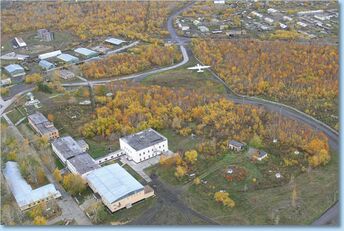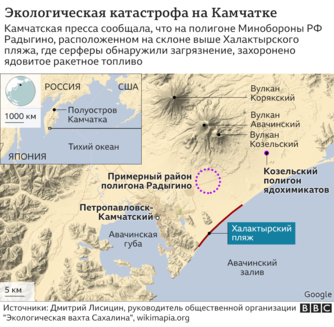Heptyl
Unsymmetrical dimethylhydrazine [1]
 Kamchatka Missile Base, 56.3091, 160.8409
Kamchatka Missile Base, 56.3091, 160.8409
 Radygino as one of sources of contamination [2]
Radygino as one of sources of contamination [2]
 Storage of missile fuel at Avacha Bay 52.9573,158.4352
Storage of missile fuel at Avacha Bay 52.9573,158.4352
Heptyl (Гептил) is Russian toxic missile fuel, reported to cause problms with its storage, using, leaking and the resulting ecological disasters.[3][4][5]. Such a Heptil is based on \(\rm NH_2 N (CH_3)_2 \).
Also, term heptyl may denote any of many isomeric univalent hydrocarbon radicals, C7H15, formally derived from heptane by the loss of a hydrogen atom. [6].
In TORI, the only first meaning is used.
Chemical content
It seems, usually, Heptyl appears as mixture of the following chemicals [3]: Unsymmetrical dimethylhydrazine, Kerosene and nitrogen tetroxide (dinytrogen tetroxyde, oxydizer),
Unsymmetrical dimethylhydrazine seems to be most toxic component of the fuel.
2020.10.01.Kamchatka disaster
Heptyl and/or Samin) seem to be main contaminants, that caused the 2020.10.01.Kamchatka disaster [7].
In report [8] by Rosprirodnadzor, concentrations of Heptyl and Samin are not estimated even by orders of magnitude. This observation is considered as indirect confirmation of the hypothesis about heptyl and samin as main contaminants, although hypotheses about leaks of components of a chemical weapon or unstable isotopes also remain; estimates of their concentrations also are not presented in the Russian oficial publications (or the access to these publications is blocked by the Roskomnadzor).
Contamination had been reported to occur in many rivers, lakes, bays and beaches of Kamchatka peninsula. The disaster cannot be interpreted as result of a single accidental release of toxic chemicals. It looks as the intentional, sinchronyzed sabotage of many commanders of various military bases; perhaps, with goal to poison the population of Kamchatka, with involvement of officials of Roskomnadzor and Rosprirodnadzor, in order not to allow the information about the contamination to be distributed before it scales-up to the ecological disaster. Several sources of the missile fuel can be used to provide the level of contamination, desired by the organizers.
Heptyl and other contaminants could come from the Kamchatka Missile Base ("Kluchi", 56.309, 160.841 ) by the Kamchatka river and to drift with the oceanic water along the Kamchatka coast to the Khalakryrsky beach and Avaha Bay.
Another source is the military polygon Radygino [2][9] near Avacha Bay.
One more source of the missile fuel as contaminant is shown at the map of the Avacha Bay by Wikimapia at 52.9573,158.4352 , just at the East side of the Avacha Bay.
Synchronization of release of the missile fuel (including heptyl) by the Russian military commanders can be explained also in terms of the Broken windows theory [10]: the commanders observe the sabotage from side of Rosprirodnadzor and kryshevanie of contamination from side of Roskomnadzor; they see colleagues, contaminating Kamchatka; so, the commanders have seduction to join the "club of poisoners", who contaminate Kamchatka, and worse the contamination, dropping even more toxic substances into rivers and bays of Kamchatka.
Appearance of contaminants and, perhaps, heptyl at rivers and bays of Kamchatka should not look strange: there are many military bases with toxic materials; the total corruption of the Russian administration makes impossible to control them, keep them in save conditions. Such a property of a corrupted society is characterized with epithets Upper Volta with missiles and Monkey with grenade (Oбезьяна с гранатой).
References
- ↑ https://space.stackexchange.com/questions/43349/why-do-russian-rocket-engineers-call-c%E2%82%82h%E2%82%88n%E2%82%82-heptyl Unsymmetrical dimethlyhydrazine or "UDMH" is a propellant which has been used by Russian, American, European, Chinese, and Indian rockets.
- ↑ 2.0 2.1 https://www.bbc.com/russian/features-54423016 Экологическая катастрофа на Камчатке: что не так с версиями властей? Мария Киселева, Екатерина Седлярова. Би-би-си. 5 октября 2020
- ↑ 3.0 3.1 https://www.themoscowtimes.com/2014/01/23/toxic-russian-rocket-fuel-target-of-kazakh-anger-a31380 Matthew Bodner. Toxic Russian Rocket Fuel Target of Kazakh Anger. Jan. 23, 2014. A nationalist political party in Kazakhstan has called on the government to ban future launches of Russian Proton-M carrier rockets from the Baikonur Cosmodrome over concerns that they spew a particularly toxic form of rocket fuel into the Kazakh steppe. // The Proton-M is the workhorse of Russia's unmanned and commercial space programs. It uses a type of fuel called heptyl, which is a highly corrosive combination of hydrazine and nitrogen tetroxide, topped off with kerosene.
- ↑ https://advanced-television.com/2013/11/25/kazakhstan-wants-85m-for-rocket-disaster/ Chris Forrester. Kazakhstan wants $85m for rocket disaster. November 25, 2013. A failed Proton-M rocket which exploded seconds after lift-off caused $85 million of damage, say Kazakh officials at the Baikonur launch site. A bill has been submitted to the Russian Federal Space Agency (Roscosmos), said the Kazakhstan Ministry of the Environment & Water in a statement. The rocket was carrying 600 tons of highly toxic heptyl rocket fuel// The Baikonur cosmodrome is the largest space-launch complex in the world, and as well as being the base from which Yuri Gagarin and the other space pioneers lifted off, is also home to many of Russia’s ballistic missile silos.// Russia rents the 100 km wide site and has a lease on the complex until 2050. Russia pays the Kazakhs $115 million annually in lease payments.
- ↑ https://www.kommersant.ru/doc/2224731 "Гептил поражает буквально все системы организма человека". "Коммерсантъ FM" от 02.07.2013, 14:47. Эксперты опасаются, что после падения ракеты-носителя "Протон-М" на землю могло попасть большое количество ядовитых веществ — гептила и амила. Директор по программам "Гринпис Россия" Иван Блоков ответил на вопросы ведущего Максима Митченкова.// 2 июля ракета-носитель "Протон-М" с тремя спутниками ГЛОНАСС разбилась через минуту после взлета с космодрома Байконур. На борту ракеты находилось 600 тонн топлива.
- ↑ https://en.wiktionary.org/wiki/heptyl (organic chemistry) Any of many isomeric univalent hydrocarbon radicals, C7H15, formally derived from heptane by the loss of a hydrogen atom.
- ↑ https://www.news18.com/news/buzz/russian-sea-toxic-waste-which-caused-mass-death-has-now-formed-a-moving-slick-2945587.html Russian Sea Toxic Waste Which Caused 'Mass Death' Has Now Formed a 'Moving Slick'. Several experts suggested that toxic rocket fuel such as heptyl or samin and melange from a nearby military facility could be responsible for the damage. Last Updated: October 9, 2020, 11:46 IST
- ↑ https://rpn.gov.ru/upload/iblock/c9e/Результаты%20анализа%20проб%20природной%20воды%20на%20содержание%20ЗВ%20по%20Халактырскому%20пляжу%20.pdf Филиал ФГБУ «ЦЛАТИ по ДФО» -ЦЛАТИ по Камчатскому краю1Результаты анализа проб природной воды на содержание загрязняющих веществ, отобранных при чрезвычайной ситуации на основании заявок Дальневосточного межрегионального управления Росприроднадзора отбор проб 01.10.2020(отбор ЦЛАТИ по Камчатскому краю.
- ↑ https://www.theguardian.com/world/2020/oct/05/marine-poisoning-in-kamchatka-russia-may-be-rocket-fuel-leak Russian rocket fuel leak likely cause of marine animal deaths. Agence France-Presse // Mon 5 Oct 2020 18.44 BST // Injured surfers and large number of dead sea creatures reported in Kamchatka region. // Water pollution in Russia’s Kamchatka peninsula that caused sea creatures to wash up dead on beaches has prompted fears that rocket fuel stored in the region’s military testing grounds may have leaked. // The pollution came to light late last month after surfers reported stinging eyes and said the water had changed colour and developed an odour. Officials later confirmed the surfers had sustained mild burns to their corneas.
- ↑ https://en.wikipedia.org/wiki/Broken_windows_theory The broken windows theory is a criminological theory that states that visible signs of crime, anti-social behavior, and civil disorder create an urban environment that encourages further crime and disorder, including serious crimes. The theory suggests that policing methods that target minor crimes, such as vandalism, loitering, public drinking, jaywalking and fare evasion, help to create an atmosphere of order and lawfulness, thereby preventing more serious crimes.
https://en.wikipedia.org/wiki/Unsymmetrical_dimethylhydrazine Unsymmetrical dimethylhydrazine (UDMH; 1,1-dimethylhydrazine ; heptyl) is a chemical compound with the formula H2NN(CH3)2 that is used as a rocket propellant. It is a colorless liquid, with a sharp, fishy, ammonia-like smell typical for organic amines. Samples turn yellowish on exposure to air and absorb oxygen and carbon dioxide. It is miscible with water, ethanol, and kerosene. In concentration between 2.5% and 95% in air, its vapors are flammable. It is not sensitive to shock. Symmetrical dimethylhydrazine, 1,2-dimethylhydrazine is also known but is not as useful.[4]
Keywords
2020.10.01.Kamchatka disaster, Corruption, Kryshevanie, Roskomnadzor, Rosprirodnadzor, Russia, Upper Volta with missiles, USSR,

